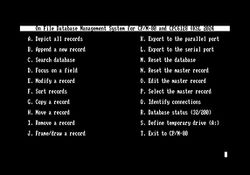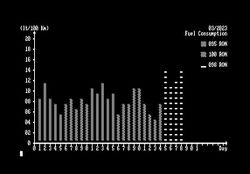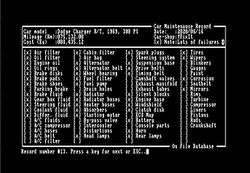Difference between revisions of "On File"
m |
|||
| (31 intermediate revisions by the same user not shown) | |||
| Line 1: | Line 1: | ||
| − | [[Image:On_File_Main_Menu.jpg|right|thumb|250px|On File main menu]] | + | [[Image:On_File_Main_Menu.jpg|right|thumb|250px|On File (2024) main menu]] |
[[Image:On_File_typical_record.jpg|right|thumb|250px|On File fuel consumption record]] | [[Image:On_File_typical_record.jpg|right|thumb|250px|On File fuel consumption record]] | ||
[[Image:On_File_Car_Maintenance_Record.jpg|right|thumb|250px|On File car maintenance record]] | [[Image:On_File_Car_Maintenance_Record.jpg|right|thumb|250px|On File car maintenance record]] | ||
| − | '''On File''' Database Management System was released in June 2024 by [[KSL]] in order to celebrate the anniversaries of CPC (40 years!) and CP/M-80 (50 years!). On File is a business application similar to the MSDOS-era PC applications and one of the most recent | + | '''On File (2024)''' Database Management System was released in June 2024 by [[KSL]] in order to celebrate the anniversaries of CPC (40 years!) and CP/M-80 (50 years!). On File is a business application similar to the MSDOS-era PC applications and one of the most recent projects developed for CP/M. As per [[Cosmos]], On File has been developed on the basis of all the hardware peripherals as well as the software that were (contemporary) available for the CP/M and the CPC6128. However, it can run on a standard single drive CPC6128. On File database is efficient, quick and reliable and can be used on an everyday basis using the CPC emulators. On File database uses the entire CPC screen as the platform for the records; thus there is plenty of space to edit user-defined fields. In addition, a wide variety of characters and symbols can be included in the fileds, hence the records can contain data beyond the typical and traditional text type. Setting up a new database using On File database is very easy and can be performed in three steps: 1) start the new file system by resetting the database and the master record, 2) frame/draw and edit the structure of the master record, 3) append new records in the database on the basis of the master record. On File database is fully dynamic, thus the user can modify the master record as well as any record anytime. Furthermore, the database can be either flat or relational. Children records include the ^ symbol followed by the relational key and one space, for example ^Z80 . Parent records include the relational key (not the ^ symbol) followed by one space, for example Z80 . On File database has maximum capacity of 200 records (400 KB). The original disk (2024) contains the boot sectors for CP/M 2.2 (Dobbertin v1.2), a few demo master records (*.002 files), a few database examples, the application (COM file), as well as the color screen saver. |
| − | + | ||
| − | + | ||
| − | + | ||
| − | + | ||
| + | '''On File (2025)''' Database Management System will be released in summer 2025 and will include the options to Group and to Invert the records, to index the database, to perform index based search and support for [[GSX]]. It wil also include '''On File Register''', a RAM-disk based register book. The latter will provide capacity for a few thousands of single-field records. Hence, the user can set up e.g. a Register of Earthquakes (date, time, location, magnitude, depth, duration) using On File Register, while keeping detailed records of specific earthquakes (e.g. > 6 R) using On File Database. On File 2025 requires RAM expansion to run and has a resume option in order to access the RAM-disk contents upon restart. | ||
| − | + | On File database (2024/2025) is disk-based, thus all the records are stored in the disk drive as stand-alone files. On the other hand, On File Register uses a single file to store the records in the RAM-disk. For large register books which contain more than 64 records, a 16 KB "cache" memory is implemented in order to be able to move back and forth while reading the records. Notice, that in the 2025 version, in order to maximize the free directory entries and to overcome the Compiler and Editor Overflow, a big part of the On File source code (ONFILE.COM) has been '''encapsulated in the source code''' of the Register Book (REGISTER.COM) and is accessed upon user request via boolean expressions that are temporarily stored in the RAM-disk. | |
== Download == | == Download == | ||
Latest revision as of 16:33, 30 April 2025
On File (2024) Database Management System was released in June 2024 by KSL in order to celebrate the anniversaries of CPC (40 years!) and CP/M-80 (50 years!). On File is a business application similar to the MSDOS-era PC applications and one of the most recent projects developed for CP/M. As per Cosmos, On File has been developed on the basis of all the hardware peripherals as well as the software that were (contemporary) available for the CP/M and the CPC6128. However, it can run on a standard single drive CPC6128. On File database is efficient, quick and reliable and can be used on an everyday basis using the CPC emulators. On File database uses the entire CPC screen as the platform for the records; thus there is plenty of space to edit user-defined fields. In addition, a wide variety of characters and symbols can be included in the fileds, hence the records can contain data beyond the typical and traditional text type. Setting up a new database using On File database is very easy and can be performed in three steps: 1) start the new file system by resetting the database and the master record, 2) frame/draw and edit the structure of the master record, 3) append new records in the database on the basis of the master record. On File database is fully dynamic, thus the user can modify the master record as well as any record anytime. Furthermore, the database can be either flat or relational. Children records include the ^ symbol followed by the relational key and one space, for example ^Z80 . Parent records include the relational key (not the ^ symbol) followed by one space, for example Z80 . On File database has maximum capacity of 200 records (400 KB). The original disk (2024) contains the boot sectors for CP/M 2.2 (Dobbertin v1.2), a few demo master records (*.002 files), a few database examples, the application (COM file), as well as the color screen saver.
On File (2025) Database Management System will be released in summer 2025 and will include the options to Group and to Invert the records, to index the database, to perform index based search and support for GSX. It wil also include On File Register, a RAM-disk based register book. The latter will provide capacity for a few thousands of single-field records. Hence, the user can set up e.g. a Register of Earthquakes (date, time, location, magnitude, depth, duration) using On File Register, while keeping detailed records of specific earthquakes (e.g. > 6 R) using On File Database. On File 2025 requires RAM expansion to run and has a resume option in order to access the RAM-disk contents upon restart.
On File database (2024/2025) is disk-based, thus all the records are stored in the disk drive as stand-alone files. On the other hand, On File Register uses a single file to store the records in the RAM-disk. For large register books which contain more than 64 records, a 16 KB "cache" memory is implemented in order to be able to move back and forth while reading the records. Notice, that in the 2025 version, in order to maximize the free directory entries and to overcome the Compiler and Editor Overflow, a big part of the On File source code (ONFILE.COM) has been encapsulated in the source code of the Register Book (REGISTER.COM) and is accessed upon user request via boolean expressions that are temporarily stored in the RAM-disk.


